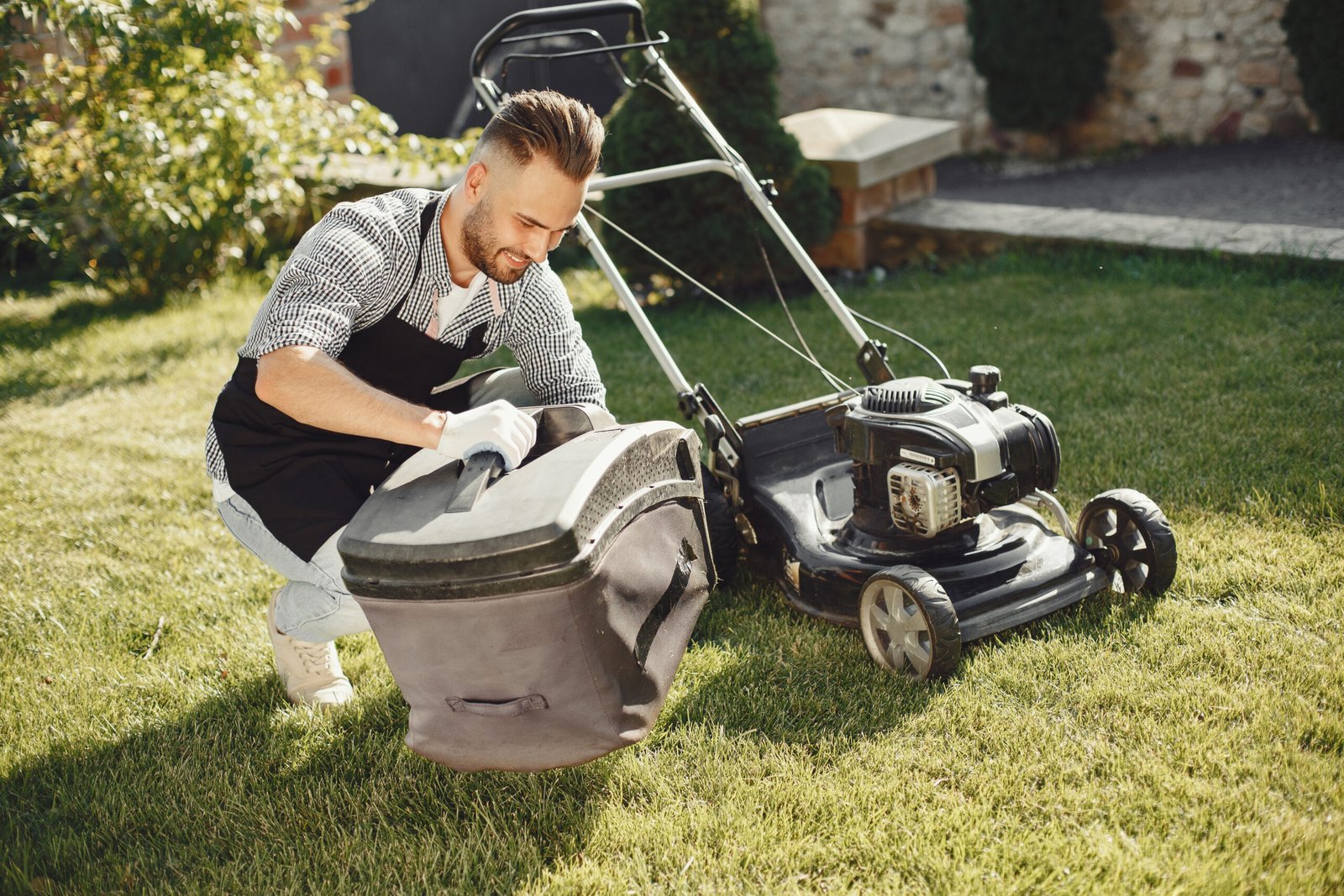When the mowing season ends, one common question that arises for homeowners is how to store a lawn mower in the garage. Many people struggle with this because improper storage can lead to rust, engine problems, and costly repairs when you’re ready to start mowing again. Fortunately, it doesn’t have to be hard to keep your lawn mower in good shape all winter. In this article, we will discuss some concrete garage storage tips to maintain your lawn mower and guarantee it is ready for the next season.
Let’s start with the method of properly keeping your lawnmower step by step, including some very brief tips.
- Clean the mower thoroughly.
- Drain the fuel and oil.
- Remove or disconnect the battery.
- Store in a dry and secure garage space.
Now that you get the essential steps, let me explain each of them in detail that can help you to know how to do the entire procedure of mowing your lawn and storing it during the off-season.
Why Proper Lawn Mower Storage is Essential
Why proper storage is so important because lawnmowers are prone to damage during the off-season if not stored correctly. The problems (such as corrosion, battery drain, and fuel system clogging) are just a few of the complications that possibly elapse. You should do it the right way, so you don’t have to pay for it, and on the contrary, you can even make your mower live longer.
Step 1: Thoroughly Clean the Lawn Mower
The number one thing to do when getting the grass cutter ready for the time when it will not be used in the garden anymore is to clean it properly. Helping grass clippings, dirt, and other debris away from the mower body will rust the item and cause other problems as is usually the case when left on the mower for some time. These are the steps to clean your mower:
- Remove the Mower Blade: Before you start the cleaning procedure, make sure your electric lawn mower is off and unplugged (if it’s electric). In the case of a gas mower, don’t forget to disconnect the spark plug to avoid any accidental starts. Take off the blade with care, of course, using a wrench.
- Scrape Off Grass and Dirt: A plastic scraper is suitable for getting any caked-on grass or dirt off the mower deck. Besides checking the underside of the mower (in particular the part where the grass gets stuck), ensure that it is clean as well.
- Clean the Air Filter and Vents: A clogged air filter can cause a malfunction in the engine, therefore, you should check the filter and the vents. You can clean the air filter by blowing compressed air or even replacing it in case of necessity.
- Rinse the Mower: After finishing the scratching of the debris, you can gently rinse the mower with a garden hose. Be cautious to prevent water from getting into the engine or electrical parts.
Step 2: Drain the Fuel and Oil
If you leave old fuel and oil in the mower while storing it, you risk the engine and the next spring starter very hard. This is how to drain both safely:
- You should remove old fuel: In case there is still the gas left in your lawn mower, get it into a proper container or use a fuel siphon. You can let the mower run until the tank is empty. The old fuel might clog carburetors and so, it is not likely that it can be set aside prior to the period of storage.
- Change the oil: Gas-powered machines need to be treated to a regular oil change too. After the cleaning of the flip, refer to the oil drain plug and make the old oil to drain into a pan. According to your mower’s manual, put in the new fresh oil instead of the old one.
- If you can’t completely drain the fuel, you can add a fuel stabilizer to the gas tank to keep the fuel fresh during the winter months.
Step 3: Disconnect and Remove the Battery
With a battery-powered lawnmower, it’s essential to correctly detach and store the battery if it’s not going to be used for a while. If the battery is left connected it can be drained over time or it can lead to corrosion as time goes on. Please bear in mind the following:
- Turn Off the Mower: Make sure that the lawnmower is properly turned off and removed from the power supply.
- Remove the Battery: The battery installation area is the place for the battery and the battery cables are retrieved with the help of the wrench. The removal of the battery and the cleaning of the terminals are also options if necessary.
- Store the Battery: Keep the battery in a cool, dry place and keep away from direct contact with concrete as it releases the battery. A board on top of the battery or a plastic one is a great idea.
Step 4: Lubricate Moving Parts
If you put a mower in storage, metal parts can get stuck with rust or become hard to move. So the maintenance of the moving parts of your lawnmower by lubricating them is a must. This is in particular where you should direct your attention to:
- Use a Light Oil: Lubricate the wheels, axles, and cables by applying light oil or a dedicated lubricant to the mower. This way, there will be no rusting, and no moving noises will occur when you uses the mower next.
- Grease the Bearings: Your owner’s manual will have the proper way of greasing up your mower’s bearings. This will make sure that they are in a good state during storage.
Step 5: Cover the Lawn Mower
Leaving a lawn mower unprotected is like causing it to come into contact with dust, water as well as harmful insects, and that will destroy it. The magic of the cover is that it provides the best defense during the off-season. Here is what can be considered:
- Buy a Worthwhile Lawn Mower Cover: A lawn mower cover made out of robust and weather-resistant fabric is good enough to keep your mower away from various pressures of moisture, dust, and other nastiness in your garage.
- Other Covers: If by chance you don’t have a cover, an if-specific solution is to use a tarp. But before that, it is necessary to secure the tarp so that it won’t be exposed to the elements of the weather.
Step 6: Find the Right Spot in the Garage
Now that your lawn mower is cleaned, drained, lubricated, and covered, the next step is choosing the right storage place in your garage. Moreover, here are some tips:
- Select a Dry Place: Moisture is the mower’s enemy during the offseason. Do not store it near windows. Choose secure, dry, and well-ventilated areas. No; doors, or areas, and if water gets in it will start to rust-the worst enemy of all grass mowers-by keeping it dry.
- Elevate the Mower (Optional): If it is convenient, put the mower onto a wooden pallet or up on an elevated position. It’s a wooden pallet or some higher surface you can hide it there
- Secure the Area: The place should be secure enough and at the same time, it should be the one where you can install the one that won’t shake while mowing the yard.
Additional Tips for Long-Term Lawn Mower Storage
Besides these major instructions, there are some other advice that you can store your lawn mower in top shape when not in use.
1. Check the Mower Blades
It’s advisable to change your blunts with sharp or new blades during the no-mowing season. Dull blades can destroy the grass that they are supposed to cut, and your lawn might become uneven. In the case of damaged blades, take them out and install the new ones before the mower is put away.
2. Inspect the Cables and Belts
Examine all the cables and belts on the machine for any signs of damage or wear. Replace those that are ripped or hanging. When spring arrives, your mower will not cause any unexpected issues if you do this.
3. Tighten Bolts and Screws
By and by, the resonance of mowing can lead to screws and bolts coming loose. Look at your mower and tighten any screws or bolts that may have loosened. This will stop parts from dropping off or getting damaged while they are in storage.
Common Lawn Mower Storage Mistakes to Avoid
Poor decisions, though made with the best intentions, are widely practiced by homeowners at times when attempting to store their lawnmowers. Here are some pitfalls to avoid:
1. Storing with Fuel in the Tank
This can lead to a lot of oil-waste problems, like if the engine doesn’t start properly. Make sure to drain or use a stabilizer for the fuel prior to storage.
2. Neglecting to Clean the Mower
Exposure of a wheeled object to dirt tends to lead more to rust and mechanical failures than would an electromagnet with the same level of abrasion. Maintenance during the storage period is mandatory to keep it in the best running condition.
3. Improper Battery Storage
Leaving the battery connected during the off-season can cause it to discharge or corrode. Always, beware of and remove the battery only after disconnecting it to a safer place of storage.
Preparing for the Next Season
At the revival of the mowing season, a suitably stored mower should run smoothly without any hindrance. Nonetheless, still, a couple of big steps must be taken to prepare your lawnmower for use:
- Reattach the Battery: Reattach the battery you removed and make sure the terminals are dirt-free.
- Refill with Fresh Oil and Fuel: Before kick-starting your mower, fill it with new oil and gas. This way, the engine problems can be avoided, along with the easy operation of it.
- Inspect for Any Issues: Prior to driving the mower, check for any parts that may have been scratched or crashed during the period of storage, to see if it is okay.
Conclusion
Properly keeping and storing your lawn mower during the off-season is vitally important to prolonging its life and avoiding those heavy-costing repairs. The mere fact that you soon follow the instructions given by the guide, means that the mower is almost ready for the following mowing season. Be it by cleaning and unloading the fuel to the perfect hangar in your garage, this step-by-step guide will enable you to store the mower confidently.







